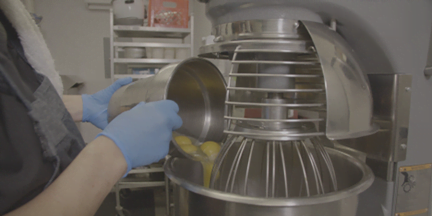As an independent restaurant owner, no matter your specialty, you likely have two important goals in mind — to provide good service and to bring fresh, creative recipes to customers. To do that, training restaurant staff must be a priority.
Food safety training is important for employees, but so is proper training on the use of kitchen equipment. Employees who are well versed in cleaning and caring for food prep equipment, like mixers, food processors and slicers, can help your kitchen become more efficient. Knowing how to use this equipment correctly can also go far in creating high-quality food.
Equipment sanitization
Proper cleaning and sanitization of food prep equipment is critical in any restaurant — and it doesn’t have to be complicated or time-consuming. Some best practices can help you and your staff.
First, it’s important to know that you can clean several components in the dishwasher to save time and labor. These include the flat beater and dough hook attachments for your mixer, along with the bowl, and the food processor chute. Cast aluminum components may change color slightly after being washed (due to oxidation), but they are still fully functional. You can also clean stainless steel food processor parts in a dishwasher.
When cleaning and sanitizing food prep equipment manually, there are a few things to keep in mind for each type. Before starting, always be sure to unplug the equipment.
Mixers
Use mild soap and water in a three-compartment sink (including a sanitizer) to wash all removable parts of the mixer. Be sure to wipe down the mixer itself, as well, to remove any food that may have gotten on the base.
Food processors
Disassemble all removable parts and wash with warm water and a mild detergent in a three-compartment sink that contains a sanitizer. Use a damp cloth to clean the exterior of the food processor. Clean after every use to avoid harboring bacteria or risking cross- contamination from various foods.
Slicers
Removable slicer blades can be cleaned in a dishwasher. You should wipe down the remaining parts with a clean, soapy towel. Using a spray bottle of sanitizer, spray down the equipment as a final step.
Slicers that don’t have removable blades require a “flossing” technique for cleaning. This involves carefully weaving a damp, soapy cloth around the blade and gently moving it back and forth to remove any food remnants. Afterward, sanitize using a spray bottle.
Equipment care
In addition to cleaning and sanitizing food prep equipment, there are steps you can take to keep it in top shape.
For example, visually inspect the blades on your food processor to be sure they are intact, since this will help ensure the cleanest cut. To remove any food pieces from a dicing grid before cleaning, use a potato or carrot to push them out; never hit the grid against a table or trash bin because that will damage the component.
Store food processor blades on wall hooks instead of in a drawer. This will make them easily visible and help keep them from getting damaged. It is also a safer way to store them.
For convenience and organization, consider adding a mixer cart to your kitchen. These carts have pegs to hold mixing attachments, which makes it easy to find the right one when you need it. They are also a good place to dry the attachments.
Making it work
Remember, proper restaurant employee training is the foundation of success when it comes to cleaning and caring for food prep equipment. Be sure to take advantage of the tools provided by equipment manufacturers, such as wall charts, videos and literature, to help make that training and your daily interaction with mixers, food processors and slicers easier.



